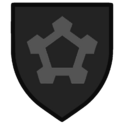NV Norvish Ground Force
| Norvish Ground Forces | |
|---|---|
 Emblem of the Ground Forces | |
| Founded | 1837 |
| Country | |
| Type | Army |
| Role | Land warfare |
| Size | 69,261 (2022):
|
| Part of | Norvish Armed Forces |
| Headquarters | Ashborne & Atnester |
| Motto(s) | We Strike, We Vanquish |
| Engagements |
|
| Budget | ℟3.52 billion (29.4% of Armed Force Budget) |
| Commanders | |
| Chief of Staff | Chesley Mosfield |
| Commander | Threnton Maurence |
| Sergeant Major | Arbern T. Palmer |
The Norvish Land Forces, or Norvish Army, is the core branch of the Norvish Armed Forces responsible for land-based military operations. The army was formed on November, 1837, after the collapse of the Bakyernnian authority. Significant campaigns since the foundation of the army include suppression of rebellions in major cities from the Friction era in 1913s to the present day, combat in the War of the Broken Hills, the 1958 nationalist uprising (civil war) and the current Norvish involvement in the Anterian Peacekeeping Force.
The tasks of the ground force are laid out in the Constitution of the countey: defend the territory of the republic (including the Grimburg isles) and of its allies, protect and advance the international legal order and to support the (local) government in law enforcement, disaster relief and humanitarian aid, both nationally and internationally. The supreme authority over the armed forces of Norvinia is exercised by the government (consisting of the President, Chief of Staffs and Ministry of Defense)
From late 2000s, the Norvish Ground Force (along with the rest of the Armed Forces) saw its personnel strengths slightly decreased to a similar level as the previous decade and in turn, mass training, exercises and modernization program had brought the defense force to a majorpower's technological level. Factors that contributed to this growth include the growing tension among Sekidean Union member with Thuadian countries, as well as a renewal of the Bakyernnian-Norvish rivalry.
Organization
Command Structure
The command structure within the Ground Forces is hierarchical; with brigades and regiments controlling groupings of units from an administrative perspective. Major units are brigade-sized (6,000 Troops), with minor units being company (~200 Troops) to battalion (~800 Troops) sized sub-units. In some Regiments and Corps called squadrons or batteries, sub-divided into platoons or troops. Command of the Army is exercised by the Chief of General Staffs within the order of the President and MoD. The Ground Force National Defence Headquarters located in Atnester, Gwinneth. There are also a number of Directorates responsible for development and implementation of policies within the Army regarding technological and operational areas. They also handle administrative affairs. As of 2020, command structure include the following:
Units
Although divisions exist as the main driving unit of many nation, having the role of forward commands, the Norvish Ground Forces is mainly organized in brigades, that follow the typical standards consisting of five battalions, three to four manueuvre, one artillery, one support and some other company sized formations. According to the latest developments, Norvish Ground Forces will station 7 main units, with all brigades will acquire sufficient amount of both light and heavy equipment, largely eliminating the distinction between infantry and mechanized formations, thus creating a combined arms unit, which could also be named Brigade Combat Group.
Modernization
The Ground Forces are undergoing a three-stage modernisation. In 1968s, the first short-term stage was completed (reorganisation of the command structure and implementation of the anti-corruption internal affair department). 2001 marked the end of the second stage (operational integration and budget increase for development, reducing the number of personnel ). 2025 is the set date for when the long-term stage is to be completed (full technical integration). The stages aim at modernising the structure of the armed forces, as well as acquiring newer and improved technology that is compatible with modern standards.
Equipment
WIP




